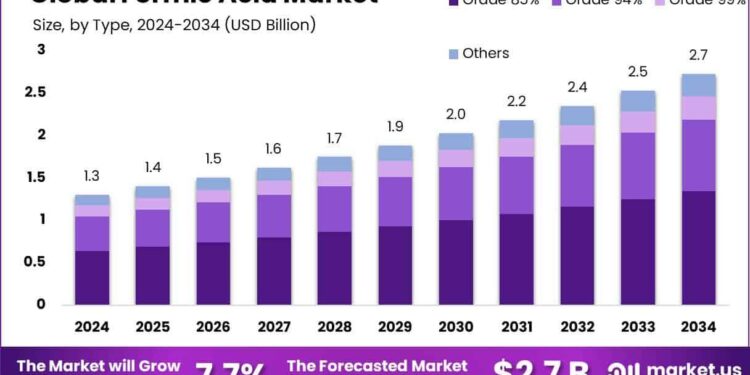The United Kingdom’s formic acid market is projected to experience moderate growth over the coming years, with a compound annual growth rate (CAGR) of approximately 1.9% through 2035, according to a recent report from IndexBox. This steady expansion reflects evolving demand dynamics across key industrial sectors, including agriculture, textiles, and leather processing. As the market navigates challenges such as fluctuating raw material prices and regulatory shifts, stakeholders are closely monitoring trends that could influence production and consumption patterns in the years ahead.
UK Formic Acid Market Growth Driven by Expanding Industrial Applications and Sustainable Practices
The UK’s formic acid market is witnessing steady expansion, primarily fueled by its versatile role in various industrial sectors. As the demand for environmentally friendly chemicals surges, manufacturers are increasingly adopting formic acid in applications ranging from leather processing and textile manufacturing to agricultural feed additives. This shift reflects a broader commitment within UK industries to integrate sustainable solutions without compromising efficiency. Notably, the construction and rubber industries have also reported a rising consumption of formic acid, underscoring the compound’s essentiality in enhancing product performance and durability.
Key factors driving market growth include:
- Enhanced regulatory frameworks promoting green chemical usage
- Rising investment in bio-based and renewable product development
- Expansion of end-user sectors embracing eco-friendly technologies
- Increased research on formic acid derivatives offering improved applications
| Sector | Projected CAGR (2024-2035) | Major Application |
|---|---|---|
| Agriculture | 2.3% | Preservative & Feed Additive |
| Textile | 1.8% | Dye Fixing Agent |
| Leather Processing | 2.1% | Tanning Agent |
| Construction | 1.6% | Curing Agent |
Regional Demand Patterns Reveal Opportunities in Manufacturing and Agriculture Sectors
Emerging trends in the UK highlight distinct regional demand variations that could significantly influence the formic acid market. In the manufacturing hubs of the Midlands and Northeast, the growing emphasis on eco-friendly preservatives and leather processing chemicals is driving steady demand. Meanwhile, agricultural zones in East Anglia and Yorkshire are increasingly relying on formic acid-based silage additives to enhance livestock feed quality. These dynamics underscore critical opportunities for stakeholders to tailor supply chains according to localized consumption patterns, promoting efficiency and market penetration.
Key regional insights include:
- Midlands and Northeast: Expansion of leather tanning industries and adhesive production bolstering formic acid uptake.
- East Anglia and Yorkshire: Intensified use in silage preservation supporting agricultural growth.
- Southwest strongholds: Emerging niche applications in specialty manufacturing under watch for future potential.
| Region | Primary Demand Driver | Projected 2035 CAGR (%) |
|---|---|---|
| Midlands | Leather & adhesive manufacturing | 2.3 |
| East Anglia | Agricultural silage additives | 2.0 |
| Yorkshire | Livestock feed enhancements | 1.8 |
| Southwest | Specialty chemical applications | 1.5 |
Strategic Recommendations for Stakeholders to Capitalize on Emerging Market Trends
To effectively leverage the projected growth in the UK’s formic acid market, stakeholders should focus on innovative product development and strategic partnerships within the chemical processing and agricultural sectors. Emphasizing sustainable sourcing and eco-friendly production methods can capture consumer interest amid rising environmental concerns. Additionally, investing in advanced distribution channels and optimizing supply chain efficiencies will be pivotal for maintaining competitive advantage as market demand grows steadily at a +1.9% CAGR through 2035.
Market players are also advised to monitor regulatory shifts closely, particularly those related to chemical safety and emissions standards, to ensure compliance and avoid potential disruptions. Expanding into niche applications such as leather tanning, textile finishing, and feed additives could further diversify revenue streams. Below is a snapshot of key focus areas for stakeholders:
| Focus Area | Strategic Action | Potential Impact |
|---|---|---|
| Eco-friendly Production | Implement green chemistry techniques | Brand differentiation & regulatory alignment |
| Supply Chain Optimization | Leverage digital tracking tools | Reduced costs & improved delivery times |
| Market Diversification | Target emerging industrial applications | Revenue growth & risk mitigation |
| Regulatory Monitoring | Establish compliance taskforces | Minimized legal risks & operational stability |
Closing Remarks
In summary, the UK’s formic acid market is poised for steady expansion, with a projected CAGR of 1.9% through 2035, according to IndexBox. While growth remains moderate, factors such as increasing industrial applications and emerging environmental regulations are expected to support sustained demand. Market stakeholders will need to navigate evolving challenges and opportunities to capitalize on this gradual upward trajectory in the coming years.
















